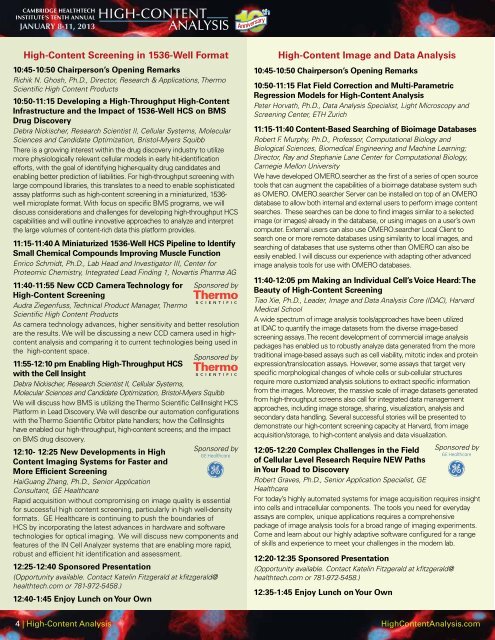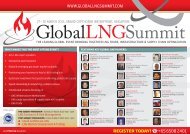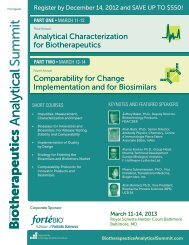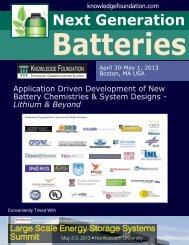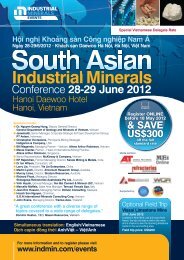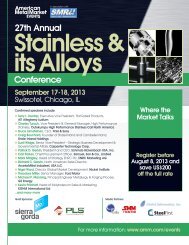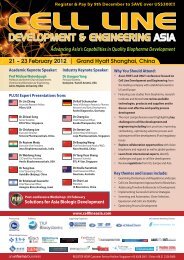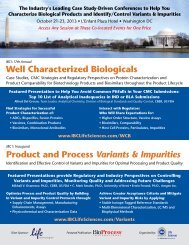HigH-Content AnAlysis
HigH-Content AnAlysis
HigH-Content AnAlysis
Create successful ePaper yourself
Turn your PDF publications into a flip-book with our unique Google optimized e-Paper software.
Cambridge Healthtech<br />
Institute’s TENTH Annual<br />
January 8-11, 2013<br />
High-<strong>Content</strong><br />
Analysis<br />
Anniversary<br />
High-<strong>Content</strong> Screening in 1536-Well Format<br />
10:45-10:50 Chairperson’s Opening Remarks<br />
Richik N. Ghosh, Ph.D., Director, Research & Applications, Thermo<br />
Scientific High <strong>Content</strong> Products<br />
10:50-11:15 Developing a High-Throughput High-<strong>Content</strong><br />
Infrastructure and the Impact of 1536-Well HCS on BMS<br />
Drug Discovery<br />
Debra Nickischer, Research Scientist II, Cellular Systems, Molecular<br />
Sciences and Candidate Optimization, Bristol-Myers Squibb<br />
There is a growing interest within the drug discovery industry to utilize<br />
more physiologically relevant cellular models in early hit-identification<br />
efforts, with the goal of identifying higher-quality drug candidates and<br />
enabling better prediction of liabilities. For high-throughput screening with<br />
large compound libraries, this translates to a need to enable sophisticated<br />
assay platforms such as high-content screening in a miniaturized, 1536-<br />
well microplate format. With focus on specific BMS programs, we will<br />
discuss considerations and challenges for developing high-throughput HCS<br />
capabilities and will outline innovative approaches to analyze and interpret<br />
the large volumes of content-rich data this platform provides.<br />
11:15-11:40 A Miniaturized 1536-Well HCS Pipeline to Identify<br />
Small Chemical Compounds Improving Muscle Function<br />
Enrico Schmidt, Ph.D., Lab Head and Investigator III, Center for<br />
Proteomic Chemistry, Integrated Lead Finding 1, Novartis Pharma AG<br />
11:40-11:55 New CCD Camera Technology for Sponsored by<br />
High-<strong>Content</strong> Screening<br />
Audra Ziegenfuss, Technical Product Manager, Thermo<br />
Scientific High <strong>Content</strong> Products<br />
As camera technology advances, higher sensitivity and better resolution<br />
are the results. We will be discussing a new CCD camera used in highcontent<br />
analysis and comparing it to current technologies being used in<br />
the high-content space.<br />
Sponsored by<br />
11:55-12:10 pm Enabling High-Throughput HCS<br />
with the Cell Insight<br />
Debra Nickischer, Research Scientist II, Cellular Systems,<br />
Molecular Sciences and Candidate Optimization, Bristol-Myers Squibb<br />
We will discuss how BMS is utilizing the Thermo Scientific CellInsight HCS<br />
Platform in Lead Discovery. We will describe our automation configurations<br />
with the Thermo Scientific Orbitor plate handlers; how the CellInsights<br />
have enabled our high-throughput, high-content screens; and the impact<br />
on BMS drug discovery.<br />
12:10- 12:25 New Developments in High<br />
Sponsored by<br />
<strong>Content</strong> Imaging Systems for Faster and<br />
More Efficient Screening<br />
HaiGuang Zhang, Ph.D., Senior Application<br />
Consultant, GE Healthcare<br />
Rapid acquisition without compromising on image quality is essential<br />
for successful high content screening, particularly in high well-density<br />
formats. GE Healthcare is continuing to push the boundaries of<br />
HCS by incorporating the latest advances in hardware and software<br />
technologies for optical imaging. We will discuss new components and<br />
features of the IN Cell Analyzer systems that are enabling more rapid,<br />
robust and efficient hit identification and assessment.<br />
12:25-12:40 Sponsored Presentation<br />
(Opportunity available. Contact Katelin Fitzgerald at kfitzgerald@<br />
healthtech.com or 781-972-5458.)<br />
12:40-1:45 Enjoy Lunch on Your Own<br />
High-<strong>Content</strong> Image and Data Analysis<br />
10:45-10:50 Chairperson’s Opening Remarks<br />
10:50-11:15 Flat Field Correction and Multi-Parametric<br />
Regression Models for High-<strong>Content</strong> Analysis<br />
Peter Horvath, Ph.D., Data Analysis Specialist, Light Microscopy and<br />
Screening Center, ETH Zurich<br />
11:15-11:40 <strong>Content</strong>-Based Searching of Bioimage Databases<br />
Robert F. Murphy, Ph.D., Professor, Computational Biology and<br />
Biological Sciences, Biomedical Engineering and Machine Learning;<br />
Director, Ray and Stephanie Lane Center for Computational Biology,<br />
Carnegie Mellon University<br />
We have developed OMERO.searcher as the first of a series of open source<br />
tools that can augment the capabilities of a bioimage database system such<br />
as OMERO. OMERO.searcher Server can be installed on top of an OMERO<br />
database to allow both internal and external users to perform image content<br />
searches. These searches can be done to find images similar to a selected<br />
image (or images) already in the database, or using images on a user’s own<br />
computer. External users can also use OMERO.searcher Local Client to<br />
search one or more remote databases using similarity to local images, and<br />
searching of databases that use systems other than OMERO can also be<br />
easily enabled. I will discuss our experience with adapting other advanced<br />
image analysis tools for use with OMERO databases.<br />
11:40-12:05 pm Making an Individual Cell’s Voice Heard: The<br />
Beauty of High-<strong>Content</strong> Screening<br />
Tiao Xie, Ph.D., Leader, Image and Data Analysis Core (IDAC), Harvard<br />
Medical School<br />
A wide spectrum of image analysis tools/approaches have been utilized<br />
at IDAC to quantify the image datasets from the diverse image-based<br />
screening assays. The recent development of commercial image analysis<br />
packages has enabled us to robustly analyze data generated from the more<br />
traditional image-based assays such as cell viability, mitotic index and protein<br />
expression/translocation assays. However, some assays that target very<br />
specific morphological changes of whole cells or sub-cellular structures<br />
require more customized analysis solutions to extract specific information<br />
from the images. Moreover, the massive scale of image datasets generated<br />
from high-throughput screens also call for integrated data management<br />
approaches, including image storage, sharing, visualization, analysis and<br />
secondary data handling. Several successful stories will be presented to<br />
demonstrate our high-content screening capacity at Harvard, from image<br />
acquisition/storage, to high-content analysis and data visualization.<br />
12:05-12:20 Complex Challenges in the Field Sponsored by<br />
of Cellular Level Research Require NEW Paths<br />
in Your Road to Discovery<br />
Robert Graves, Ph.D., Senior Application Specialist, GE<br />
Healthcare<br />
For today’s highly automated systems for image acquisition requires insight<br />
into cells and intracellular components. The tools you need for everyday<br />
assays are complex, unique applications requires a comprehensive<br />
package of image analysis tools for a broad range of imaging experiments.<br />
Come and learn about our highly adaptive software configured for a range<br />
of skills and experience to meet your challenges in the modern lab.<br />
12:20-12:35 Sponsored Presentation<br />
(Opportunity available. Contact Katelin Fitzgerald at kfitzgerald@<br />
healthtech.com or 781-972-5458.)<br />
12:35-1:45 Enjoy Lunch on Your Own<br />
4 | High-<strong>Content</strong> Analysis High<strong>Content</strong>Analysis.com


